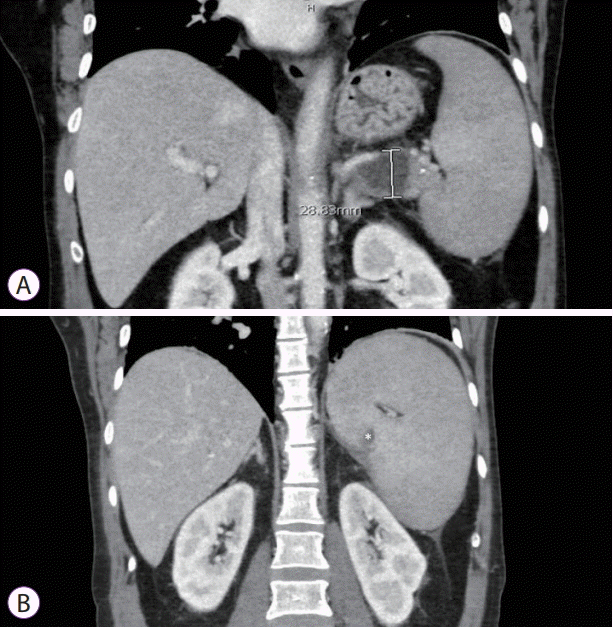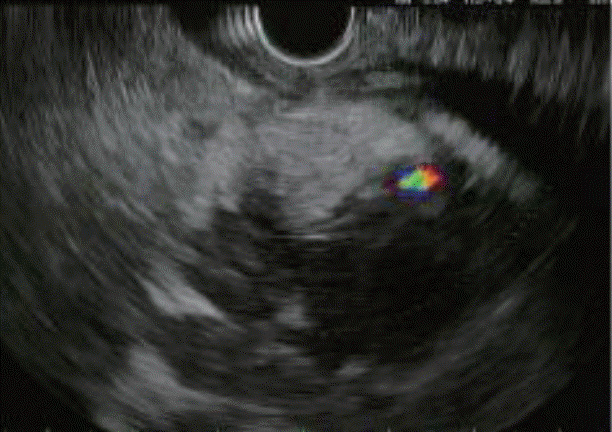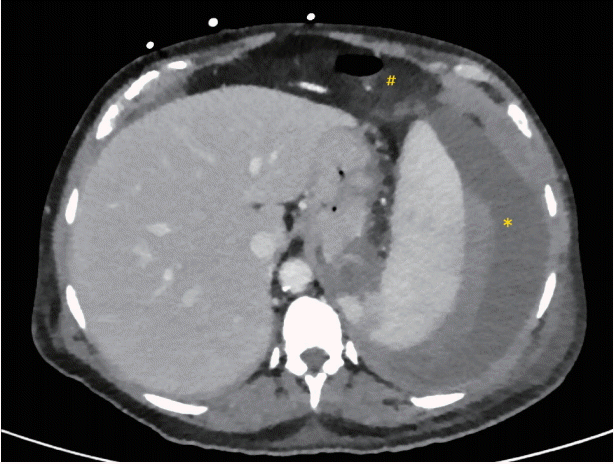|
Hernani et al. (2015) [13] Brazil |
30/M |
1) Type: acute |
1) Splenic rupture |
|
2) Etiology: alcohol |
2) Timing: on hospital day 6 |
|
3) Prior acute pancreatitis: No |
3) Management: laparotomy with splenectomy |
|
4) Chronic pancreatitis: No |
4) Outcome: complicated by infected peripancreatic collection with subsequent drainage and full recovery |
|
5) Fluid collection: acute necrotic collection |
|
6) SVT: Yes |
|
7) Splenomegaly: No |
|
Sharada et al. (2015) [14] India |
25/M |
1) Type: chronic |
1) Splenic rupture |
|
2) Etiology: alcohol |
2) Timing: on presentation |
|
3) Prior acute pancreatitis: Yes (1 episode) |
3) Management: laparotomy with splenectomy |
|
4) Chronic pancreatitis: Yes |
4) Outcome: full recovery |
|
5) Fluid collection: No |
|
6) SVT: No |
|
7) Splenomegaly: Yes |
|
Debnath et al. (2014) [15] India |
45/M |
1) Type: acute |
1) Splenic rupture |
|
2) Etiology: alcohol |
2) Timing: on presentation |
|
3) Prior acute pancreatitis: No |
3) Management: laparotomy with splenectomy |
|
4) Chronic pancreatitis: No |
4) Outcome: complicated by postoperative pancreatitis, multi-organ failure, and eventually death |
|
5) Fluid collection: No |
|
6) SVT: No |
|
7) Splenomegaly: No |
|
Cengiz et al. (2013) [16] Turkey |
38/F |
1) Type: acute |
1) Splenic rupture |
|
2) Etiology: alcohol |
2) Timing: on the presentation |
|
3) Prior acute pancreatitis: Yes (1 episode) |
3) Management: laparotomy with splenectomy |
|
4) Chronic pancreatitis: No |
4) Outcome: full recovery |
|
5) Fluid collection: pseudocyst at the tail |
|
6) SVT: No |
|
7) Splenomegaly: No |
|
Mujtaba et al. (2011) [17] USA |
37/M |
1) Type: acute |
1) Splenic rupture |
|
2) Etiology: Crohn’s disease |
2) Timing: on presentation |
|
3) Prior acute pancreatitis: No |
3) Management: conservative management with transfusion and fluid resuscitation |
|
4) Chronic pancreatitis: No |
|
5) Fluid collection: No |
4) Outcome: full recovery |
|
6) SVT: Yes |
|
7) Splenomegaly: No |
|
Tseng et al. (2008) [18] Taiwan |
32/M |
1) Type: acute |
1) Subcapsular splenic hematoma |
|
2) Etiology: alcohol |
2) Timing: on presentation |
|
3) Prior acute pancreatitis: Yes (2 episodes) |
3) Management: percutaneous drainage for 4 weeks |
|
4) Chronic pancreatitis: No |
4) Outcome: full recovery |
|
5) Fluid collection: No |
|
6) SVT: No |
|
7) Splenomegaly: No |
|
Patel et al. (2005) [19] USA |
44/M |
1) Type: acute |
1) Subcapsular splenic hematoma |
|
2) Etiology: alcohol |
2) Timing: on presentation |
|
3) Prior acute pancreatitis: No |
3) Management: conservative management |
|
4) Chronic pancreatitis: Yes |
4) Outcome: full recovery |
|
5) Fluid collection: pseudocyst at the tail |
|
6) SVT: No |
|
7) Splenomegaly: No |
|
Sawrey et al. (2013) [20] UK |
55/M |
1) Type: chronic |
1) Intracapsular splenic hematoma |
|
2) Etiology: N/A |
2) Timing: on presentation |
|
3) Prior acute pancreatitis: Yes (1 episode) |
3) Management: splenic artery embolization |
|
4) Chronic pancreatitis: Yes |
4) Outcome: in recovery |
|
5) Fluid collection: pseudocyst |
|
6) SVT: Yes |
|
7) Splenomegaly: No |
|
Huang et al. (2002) [21] Taiwan |
25/M |
1) Type: acute |
1) Splenic rupture |
|
2) Etiology: alcohol |
2) Timing: on hospital day 3 |
|
3) Prior acute pancreatitis: Yes |
3) Management: laparotomy with splenectomy |
|
4) Chronic pancreatitis: No |
4) Outcome: full recovery |
|
5) Fluid collection: No |
|
6) SVT: No |
|
7) Splenomegaly: No |
|
Kuramitsu et al. (1995) [22] Japan |
63/M |
1) Type: acute |
1) Splenic rupture |
|
2) Etiology: N/A |
2) Timing: splenic hematoma on presentation. Ruptured 1 month after |
|
3) Prior acute pancreatitis: No |
|
4) Chronic pancreatitis: Yes |
3) Management: laparotomy without splenectomy |
|
5) Fluid collection: pseudocyst at the tail |
4) Outcome: full recovery |
|
6) SVT: No |
|
7) Splenomegaly: No |
|
Zhou et al. (2016) [23] USA |
59/M |
1) Type: acute |
1) Splenic rupture |
|
2) Etiology: alcohol |
2) Timing: on hospital day 2 |
|
3) Prior acute pancreatitis: No |
3) Management: splenic artery embolization first, followed by laparotomy with splenectomy |
|
4) Chronic pancreatitis: No |
|
5) Fluid collection: No |
4) Outcome: full recovery |
|
6) SVT: Yes |
|
7) Splenomegaly: No |
|
Gandhi et al. (2010) [24] India |
35/M |
1) Type: acute |
1) Splenic rupture |
|
2) Etiology: N/A |
2) Timing: on presentation |
|
3) Prior acute pancreatitis: Yes (multiple episodes) |
3) Management: laparotomy with distal pancreatectomy and splenectomy |
|
4) Chronic pancreatitis: No |
|
5) Fluid collection: multiple pseudocysts at the tail |
4) Outcome: full recovery |
|
6) SVT: No |
|
7) Splenomegaly: No |
|
Katsanos et al. (2004) [25] Greece |
65/M |
1) Type: acute |
1) Splenic rupture |
|
2) Etiology: N/A |
2) Timing: on hospital day 6 |
|
3) Prior acute pancreatitis: Yes (multiple episodes) |
3) Management: laparotomy with splenectomy |
|
4) Chronic pancreatitis: No |
4) Outcome: full recovery |
|
5) Fluid collection: No |
|
6) SVT: No |
|
7) Splenomegaly: No |
|
Adelekan et al. (2003) [26] Not defined |
31/F |
1) Type: acute |
1) Splenic rupture |
|
2) Etiology: alcohol |
2) Timing: on presentation |
|
3) Prior acute pancreatitis: No |
3) Management: laparotomy with splenectomy and distal pancreatectomy |
|
4) Chronic pancreatitis: No |
|
5) Fluid collection: small pseudocyst in retroperitoneum |
4) Outcome: full recovery |
|
6) SVT: No |
|
7) Splenomegaly: Yes |
|
Toussi et al. (1996) [27] Ireland |
52/F |
1) Type: acute |
1) Splenic rupture |
|
2) Etiology: alcohol |
2) Timing: on hospital day 7 |
|
3) Prior acute pancreatitis: No |
3) Management: laparotomy with splenectomy |
|
4) Chronic pancreatitis: No |
4) Outcome: complicated by necrotic pancreas with a large cyst, which was managed with laparotomy with pancreatic necrosectomy. Full recovery after |
|
5) Fluid collection: No |
|
6) SVT: No |
|
7) Splenomegaly: No |
|
Catanzaro et al. (1968) [28] USA |
33/M |
1) Type: acute |
1) Splenic rupture |
|
2) Etiology: alcohol |
2) Timing: on presentation |
|
3) Prior acute pancreatitis: No |
3) Management: laparotomy with splenectomy |
|
4) Chronic pancreatitis: No |
4) Outcome: full recovery |
|
5) Fluid collection: pseudocyst at the tail |
|
6) SVT: No |
|
7) Splenomegaly: No |
|
Labree et al. (1960) [29] USA |
45/M |
1) Type: acute |
1) Splenic rupture |
|
2) Etiology: alcohol |
2) Timing: on presentation |
|
3) Prior acute pancreatitis: Yes (1 episode) |
3) Management: laparotomy without splenectomy, drainage inserted |
|
4) Chronic pancreatitis: No |
|
5) Fluid collection: small pseudocyst |
4) Outcome: complicated by a large pancreatic cyst, which was marsupialized. Full recovery after |
|
6) SVT: No |
|
7) Splenomegaly: No |
|
Moori et al. (2016) [30] UK |
29/M |
1) Type: chronic |
1) Splenic rupture |
|
2) Etiology: alcohol |
2) Timing: on hospital day 2 |
|
3) Prior acute pancreatitis: No |
3) Management: laparotomy with splenectomy and distal pancreatectomy |
|
4) Chronic pancreatitis: Yes |
|
5) Fluid collection: pseudocyst at the tail |
4) Outcome: full recovery |
|
6) SVT: No |
|
7) Splenomegaly: No |
|
Vyborny et al. (1988) [31] USA |
58/M |
1) Type: acute |
1) Subcapsular splenic hematoma |
|
2) Etiology: N/A |
2) Timing: 1 month after initial presentation |
|
3) Prior acute pancreatitis: No |
3) Management: percutaneous drainage |
|
4) Chronic pancreatitis: No |
4) Outcome: full recovery |
|
5) Fluid collection: infected pseudocyst in head and neck, and multiple small peripancreatic collections at the tail |
|
6) SVT: No |
|
7) Splenomegaly: No |
|
Moore et al. (1984) [32] Australia |
42/M |
1) Type: acute |
1) Splenic rupture |
|
2) Etiology: N/A |
2) Timing: on presentation |
|
3) Prior acute pancreatitis: Yes (1 episode) |
3) Management: laparotomy with splenectomy |
|
4) Chronic pancreatitis: Yes |
4) Outcome: full recovery |
|
5) Fluid collection: No |
|
6) SVT: No |
|
7) Splenomegaly: No |
|
Jha et al. (2011) [33] India |
45/M |
1) Type: acute |
1) Splenic rupture |
|
2) Etiology: alcohol |
2) Timing: on presentation |
|
3) Prior acute pancreatitis: No |
3) Management: laparotomy with splenectomy |
|
4) Chronic pancreatitis: Yes |
4) Outcome: full recovery |
|
5) Fluid collection: fluid along the pancreatic tail |
|
6) SVT: No |
|
7) Splenomegaly: No |
|
Torricelli et al. (2001) [34] Italy |
67/M |
1) Type: acute |
1) Splenic rupture |
|
2) Etiology: alcohol |
2) Timing: on presentation |
|
3) Prior acute pancreatitis: Yes (multiple episodes) |
3) Management: laparotomy with splenectomy |
|
4) Chronic pancreatitis: No |
4) Outcome: full recovery |
|
5) Fluid collection: pseudocyst at the tail |
|
6) SVT: No |
|
7) Splenomegaly: No |
|
Scherer et al. (1987) [35] Germany |
45/M |
1) Type: chronic |
1) Splenic rupture |
|
2) Etiology: alcohol |
2) Timing: on presentation |
|
3) Prior acute pancreatitis: Yes (multiple episodes) |
3) Management: laparotomy with splenectomy and distal pancreatectomy |
|
4) Chronic pancreatitis: Yes |
|
5) Fluid collection: pseudocyst at the tail |
4) Outcome: full recovery |
|
6) SVT: No |
|
7) Splenomegaly: Yes |
|
32/M |
1) Type: acute |
1) Splenic rupture |
|
2) Etiology: alcohol |
2) Timing: on presentation |
|
3) Prior acute pancreatitis: Yes (multiple episodes) |
3) Management: laparotomy with splenectomy and distal pancreatectomy |
|
4) Chronic pancreatitis: No |
|
5) Fluid collection: pseudocyst at the tail |
4) Outcome: complicated by suppuration in the spleen cavity |
|
6) SVT: No |
|
7) Splenomegaly: Yes |
|
Patil et al. (2011) [36] UK |
47/M |
1) Type: acute |
1) Splenic rupture |
|
2) Etiology: alcohol |
2) Timing: On hospital day 2 |
|
3) Prior acute pancreatitis: Yes (multiple episodes) |
3) Management: Laparotomy with splenectomy |
|
4) Chronic pancreatitis: No |
4) Outcome: Full recovery |
|
5) Fluid collection: No |
|
6) SVT: No |
|
7) Splenomegaly: No |
|
23/F |
1) Type: acute |
1) Splenic rupture |
|
2) Etiology: alcohol |
2) Timing: on hospital day 7 |
|
3) Prior acute pancreatitis: No |
3) Management: splenic artery embolization, followed by laparotomy with excision of splenic tissue |
|
4) Chronic pancreatitis: No |
|
5) Fluid collection: pseudocyst at the tail |
4) Outcome: full recovery |
|
6) SVT: Yes |
|
7) Splenomegaly: No |
|
45/F |
1) Type: acute |
1) Subcapsular hematoma |
|
2) Etiology: idiopathic |
2) Timing: on presentation |
|
3) Prior acute pancreatitis: Yes (1 episode) |
3) Management: conservative management |
|
4) Chronic pancreatitis: No |
4) Outcome: full recovery |
|
5) Fluid collection: No |
|
6) SVT: No |
|
7) Splenomegaly: No |




 PDF
PDF Citation
Citation Print
Print






 XML Download
XML Download